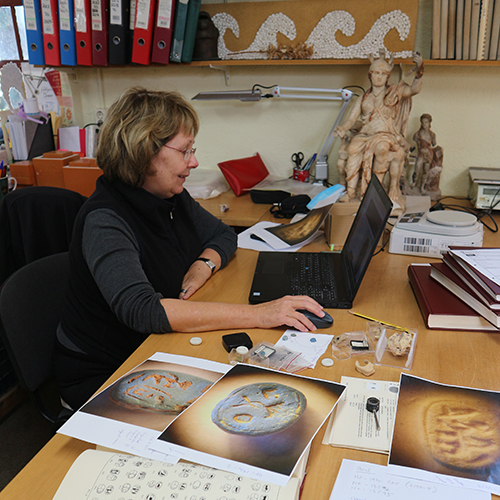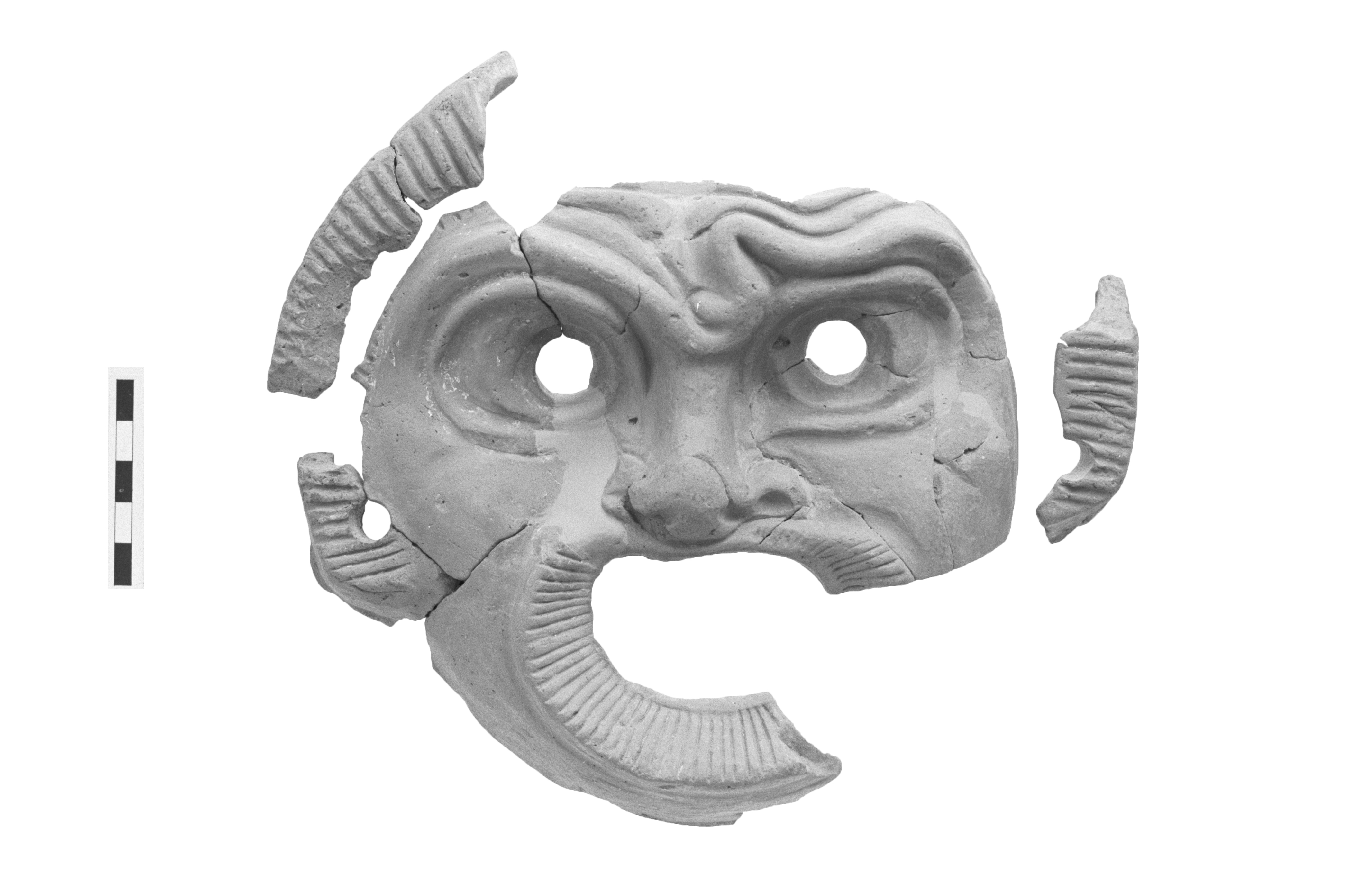
Making Objects Speak: Reflections from the Author

Sonia Klinger’s new book, The Sanctuary of Demeter and Kore: Miscellaneous Finds of Terracotta , with contributions by Gloria S. Merker and Nancy Bookidis, is the latest volume in the ASCSA’s Corinth series (Corinth XVIII.8), presenting the terracotta small finds other than figurines and large-scale sculpture. The author recently took a break from her study of the small finds in metal, stone, bone, and glass, which she is preparing to publish in a subsequent volume, to speak with us about her experience working at Corinth.

Sonia Klinger at work in the Corinth Museum
Klinger had been a student and then teaching assistant of Merker during her undergraduate and graduate studies at The Hebrew University, Jerusalem, in the 1970s. It was Merker—author of Corinth XVIII.4 on the terracotta figurines from the Sanctuary of Demeter and Kore, among many other works—who first drew her to the Corinthian material, asking her in 2004/2005 if she would like to co-author the publication of the miscellaneous small finds from the Sanctuary. “I had been an Associate Member at the School in 1979/1980 and so I knew the School’s program and had visited Corinth,” Klinger recalls, “but I had no idea what this project entailed and didn’t imagine how spectacular it would become.” Her previous research had focused on Corinthian and Attic vase painting, but she had begun publishing terracotta finds housed in the Israel Museum, Jerusalem. Nevertheless, she remembers that when she came to Corinth, “working with the various additional materials in an excavation site with all its complex issues was a totally new challenge.” Klinger describes how the work progressed over several study seasons:
At first, Gloria made a list of the finds that were known to her and sent them to me to check and study, but quickly enough it became apparent that the lots contained many more finds that needed to be included. Thus, during my first seasons I went through her lists and started adding the new finds. At the end of each season I would compile a list and a preliminary discussion and send it to Gloria, who would comment on it. During various sabbaticals I also stayed in Athens and started working in the Blegen Library in search of parallels.
After Merker’s untimely death in 2013, Klinger was urged to continue the project by another Corinthian giant, Bookidis, who had co-directed the excavations at the Sanctuary with Ronald S. Stroud in the 1960s and 1970s. Bookidis took over Merker’s work on loomweights and became a second mentor to Klinger in all matters Corinthian, especially in making sense of the difficult stratigraphy of the Sanctuary. Klinger values the guidance she received from both Bookidis and Stroud, “who guided and encouraged me, read and corrected everything I wrote, and familiarized me with the site and with the type of text that was expected from an author in the Corinth XVIII series.”

Nancy Bookidis introduces students to the Sanctuary of Demeter and Kore on Acrocorinth, with Corinth and the Corinthian Gulf in the background)
Studying such a diverse body of finds presented some unique challenges. “Early on,” Klinger explains, “it became clear that the finds needed to be organized according to material because each of them—terracotta, bronze, lead, iron, stone, faience, and glass—had idiosyncrasies dictated by the material’s limitations, specific techniques, workshops, and chronologies.” In 2016, after she had gone through all the materials at least once, she decided that it would be best to publish the terracotta finds first, not only because they were at the most advanced stage of research, but also because of their relation to many of the Sanctuary materials that had already been published: the pottery by Elizabeth G. Pemberton (Corinth XVIII.1) and Kathleen W. Slane (Corinth XVIII.2), the terracotta sculpture by Bookidis (Corinth XVIII.5), inscriptions on terracotta by Stroud (Corinth XVIII.6), and the lamps and offering trays by Bookidis and Pemberton (Corinth XVIII.7), in addition to the terracotta figurines already published by Merker (Corinth XVIII.4). Klinger recalls that one of the most difficult stages in the research process was deciding how to organize the terracotta finds for publication, once the decision had been made to publish them first. The final structure of the book, she explains, “was dictated by the finds’ relative size, quantities, and importance, so that life-sized protomes, masks, and altars, for example, needed to be presented first. I then grouped the rest according to their class, function, and possible meaning.”
Another broad challenge was discovering how the finds’ specific use and significance fit into the larger interpretation of the religious activities taking place in the Sanctuary, especially since there are very few detailed studies of miscellaneous finds from other sites that can be used as parallels to help explain those from the Sanctuary. Klinger points to some of the masks as particularly enigmatic: “they are very fragmentary, and it was difficult to assign them to their specific types and determine how Dionysos and theatrical masks fit in.” In her wide-ranging search for comparanda, she turned to publications of finds from museum collections and congresses, vase paintings, and other artistic depictions. She also looked to literary sources as useful evidence that could explain the objects’ meanings as dedications. “One fascinating type of literary source that was useful and fun,” she notes, “were the passages that appear in the Anthologia Palatina.”


Classical protome of Dionysos (left) and Roman theatrical mask (right) from the Sanctuary of Demeter and Kore
Once the detailed research on individual objects was complete and she began to write the discussion of each class, Klinger explains that she started to see “how they could fit together and supply a broader meaning. So, for example, how some of the finds could be related to the household and its space while others to the lives of women and children, and how both could be interconnected.” For Klinger, this window into the lives of ancient Corinthians was the most rewarding part of the project: “to understand the general meanings of these dedications in terms of the people, mostly Corinthian women and perhaps children, who offered them in the Sanctuary to communicate in some way with their deities.”

Archaic or Classical spinning top from the Sanctuary of Demeter and Kore. Among the terracotta dedications from the Sanctuary, tops and other toys have strong associations with the transition from childhood to adulthood.
Another reward, perhaps unexpected when Merker first asked her to become involved with the project, has been the deep connections with other Corinthian scholars forged over many years of study and research. She reflects on her experience of working at Corinth:
On a personal level, staying in Corinth for long periods was a challenge, especially in combination with a full-time teaching job at the University of Haifa. It meant living away from my family and adapting to other people’s ways. In Corinth you live in close contact, sharing bathrooms, sometimes even bedrooms, eating breakfast, lunch, and dinner together, and losing a measure of privacy. Sometimes the internet did not work, in the winter the museum closed too early and it was quite cold, and the summers were crowded and hot. But the benefits far surpassed the shortcomings. Working alongside students and scholars was enriching in more ways than I can describe, and many of these wonderful people became close friends, a family of Corinthians.

A typical afternoon in Corinth: scholars gather for ouzo at the end of the workday
As her work on the publication of the Sanctuary’s miscellaneous finds in other materials progresses, Klinger looks forward to seeing how their study will “enlarge and/or change our perception of this amazing site.” Our understanding of the Sanctuary has already benefitted greatly from her work on the terracotta finds now published in Corinth XVIII.8.